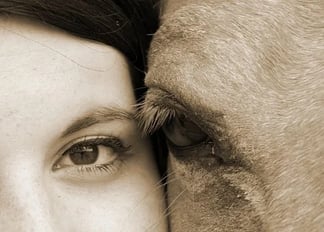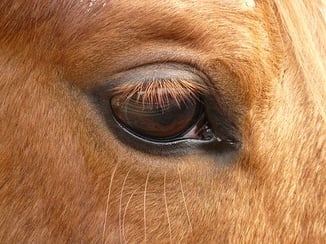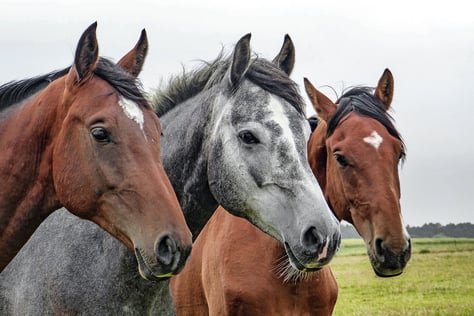Call us today (800) 444-7430
Call us today (800) 444-7430
 A horses monocular vision is not the same as human or predators vision. Horses can look at something with both eyes at the same time and will see the same thing in both eyes. However, he is still seeing two separate views. Horses can switch between monocular and binocular vision depending on the situation they are in. When they are relaxed and grazing, they can use their binocular vision. If they sense something moving behind them, they can immediately switch to their monocular version and continue looking at the grass with one eye, and checking for predators with the other. Once he realizes there is nothing there, he can relax and go back to binocular vision. The switching back and forth between looking at something with one eye vs. something with both eyes is why horses sometimes spook at inanimate objects. Your horse may have seen something with one eye, but when he turns to focus on it with both eyes, until he gets his eyes focused at looking in one direction, it can appear to the horse as if the object has moved.
A horses monocular vision is not the same as human or predators vision. Horses can look at something with both eyes at the same time and will see the same thing in both eyes. However, he is still seeing two separate views. Horses can switch between monocular and binocular vision depending on the situation they are in. When they are relaxed and grazing, they can use their binocular vision. If they sense something moving behind them, they can immediately switch to their monocular version and continue looking at the grass with one eye, and checking for predators with the other. Once he realizes there is nothing there, he can relax and go back to binocular vision. The switching back and forth between looking at something with one eye vs. something with both eyes is why horses sometimes spook at inanimate objects. Your horse may have seen something with one eye, but when he turns to focus on it with both eyes, until he gets his eyes focused at looking in one direction, it can appear to the horse as if the object has moved. Herman Snellen, horses see as well as we do in some instances. Comparing horse vision with humans, research found that horses actually see fairly well from a distance. The Snellen scale for humans is 20/20, meaning that a person can read the same line on an eye chart from 20 feet that the ‘standard’ person can also read from that same distance. Using this Snellen scale, horses rate 20/30 a dog is 20/50 and a cat is 20/75.
Herman Snellen, horses see as well as we do in some instances. Comparing horse vision with humans, research found that horses actually see fairly well from a distance. The Snellen scale for humans is 20/20, meaning that a person can read the same line on an eye chart from 20 feet that the ‘standard’ person can also read from that same distance. Using this Snellen scale, horses rate 20/30 a dog is 20/50 and a cat is 20/75.

From horse stalls to barn doors, stable flooring and entrance gates, Classic offers the widest product lines in the industry while continuing to expand through innovation and strategic alliances.
We look forward to answering your questions. Our sales team is knowledgeable about everything from horse barn design to equine stall systems and readily available to assist you in planning your Classic barn!
ph: (800) 444-7430
em: sales@classic-equine.com
